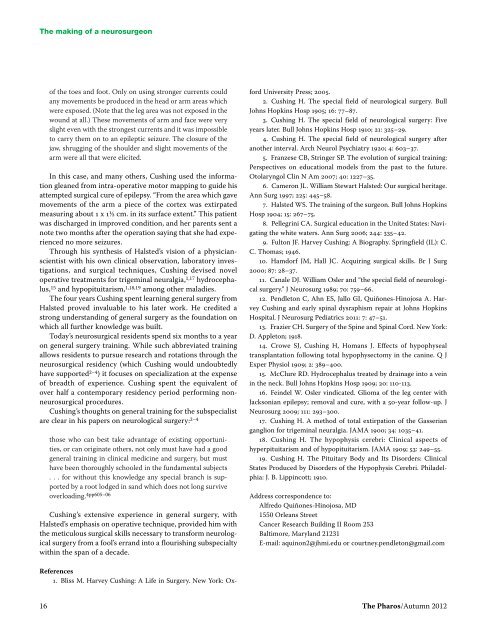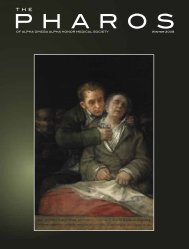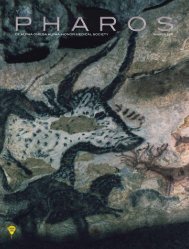The Pharos - Alpha Omega Alpha
The Pharos - Alpha Omega Alpha
The Pharos - Alpha Omega Alpha
Create successful ePaper yourself
Turn your PDF publications into a flip-book with our unique Google optimized e-Paper software.
<strong>The</strong> making of a neurosurgeon<br />
of the toes and foot. Only on using stronger currents could<br />
any movements be produced in the head or arm areas which<br />
were exposed. (Note that the leg area was not exposed in the<br />
wound at all.) <strong>The</strong>se movements of arm and face were very<br />
slight even with the strongest currents and it was impossible<br />
to carry them on to an epileptic seizure. <strong>The</strong> closure of the<br />
jaw, shrugging of the shoulder and slight movements of the<br />
arm were all that were elicited.<br />
In this case, and many others, Cushing used the information<br />
gleaned from intra-operative motor mapping to guide his<br />
attempted surgical cure of epilepsy. “From the area which gave<br />
movements of the arm a piece of the cortex was extirpated<br />
measuring about 1 x 1½ cm. in its surface extent.” This patient<br />
was discharged in improved condition, and her parents sent a<br />
note two months after the operation saying that she had experienced<br />
no more seizures.<br />
Through his synthesis of Halsted’s vision of a physicianscientist<br />
with his own clinical observation, laboratory investigations,<br />
and surgical techniques, Cushing devised novel<br />
operative treatments for trigeminal neuralgia, 1,17 hydrocephalus,<br />
15 and hypopituitarism, 1,18,19 among other maladies.<br />
<strong>The</strong> four years Cushing spent learning general surgery from<br />
Halsted proved invaluable to his later work. He credited a<br />
strong understanding of general surgery as the foundation on<br />
which all further knowledge was built.<br />
Today’s neurosurgical residents spend six months to a year<br />
on general surgery training. While such abbreviated training<br />
allows residents to pursue research and rotations through the<br />
neurosurgical residency (which Cushing would undoubtedly<br />
have supported 2–4 ) it focuses on specialization at the expense<br />
of breadth of experience. Cushing spent the equivalent of<br />
over half a contemporary residency period performing nonneurosurgical<br />
procedures.<br />
Cushing’s thoughts on general training for the subspecialist<br />
are clear in his papers on neurological surgery: 2–4<br />
those who can best take advantage of existing opportunities,<br />
or can originate others, not only must have had a good<br />
general training in clinical medicine and surgery, but must<br />
have been thoroughly schooled in the fundamental subjects<br />
. . . for without this knowledge any special branch is supported<br />
by a root lodged in sand which does not long survive<br />
overloading. 4pp605–06<br />
Cushing’s extensive experience in general surgery, with<br />
Halsted’s emphasis on operative technique, provided him with<br />
the meticulous surgical skills necessary to transform neurological<br />
surgery from a fool’s errand into a flourishing subspecialty<br />
within the span of a decade.<br />
References<br />
1. Bliss M. Harvey Cushing: A Life in Surgery. New York: Oxford<br />
University Press; 2005.<br />
2. Cushing H. <strong>The</strong> special field of neurological surgery. Bull<br />
Johns Hopkins Hosp 1905; 16: 77–87.<br />
3. Cushing H. <strong>The</strong> special field of neurological surgery: Five<br />
years later. Bull Johns Hopkins Hosp 1910; 21: 325–29.<br />
4. Cushing H. <strong>The</strong> special field of neurological surgery after<br />
another interval. Arch Neurol Psychiatry 1920; 4: 603–37.<br />
5. Franzese CB, Stringer SP. <strong>The</strong> evolution of surgical training:<br />
Perspectives on educational models from the past to the future.<br />
Otolaryngol Clin N Am 2007; 40: 1227–35.<br />
6. Cameron JL. William Stewart Halsted: Our surgical heritage.<br />
Ann Surg 1997; 225: 445–58.<br />
7. Halsted WS. <strong>The</strong> training of the surgeon. Bull Johns Hopkins<br />
Hosp 1904; 15: 267–75.<br />
8. Pellegrini CA. Surgical education in the United States: Navigating<br />
the white waters. Ann Surg 2006; 244: 335–42.<br />
9. Fulton JF. Harvey Cushing: A Biography. Springfield (IL): C.<br />
C. Thomas; 1946.<br />
10. Hamdorf JM, Hall JC. Acquiring surgical skills. Br J Surg<br />
2000; 87: 28–37.<br />
11. Canale DJ. William Osler and “the special field of neurological<br />
surgery.” J Neurosurg 1989; 70: 759–66.<br />
12. Pendleton C, Ahn ES, Jallo GI, Quiñones-Hinojosa A. Harvey<br />
Cushing and early spinal dysraphism repair at Johns Hopkins<br />
Hospital. J Neurosurg Pediatrics 2011: 7: 47–51.<br />
13. Frazier CH. Surgery of the Spine and Spinal Cord. New York:<br />
D. Appleton; 1918.<br />
14. Crowe SJ, Cushing H, Homans J. Effects of hypophyseal<br />
transplantation following total hypophysectomy in the canine. Q J<br />
Exper Physiol 1909; 2: 389–400.<br />
15. McClure RD. Hydrocephalus treated by drainage into a vein<br />
in the neck. Bull Johns Hopkins Hosp 1909; 20: 110-113.<br />
16. Feindel W. Osler vindicated. Glioma of the leg center with<br />
Jacksonian epilepsy; removal and cure, with a 50-year follow-up. J<br />
Neurosurg 2009; 111: 293–300.<br />
17. Cushing H. A method of total extirpation of the Gasserian<br />
ganglion for trigeminal neuralgia. JAMA 1900; 34: 1035–41.<br />
18. Cushing H. <strong>The</strong> hypophysis cerebri: Clinical aspects of<br />
hyperpituitarism and of hypopituitarism. JAMA 1909; 53: 249–55.<br />
19. Cushing H. <strong>The</strong> Pituitary Body and Its Disorders: Clinical<br />
States Produced by Disorders of the Hypophysis Cerebri. Philadelphia:<br />
J. B. Lippincott; 1910.<br />
Address correspondence to:<br />
Alfredo Quiñones-Hinojosa, MD<br />
1550 Orleans Street<br />
Cancer Research Building II Room 253<br />
Baltimore, Maryland 21231<br />
E-mail: aquinon2@jhmi.edu or courtney.pendleton@gmail.com<br />
16 <strong>The</strong> <strong>Pharos</strong>/Autumn 2012














